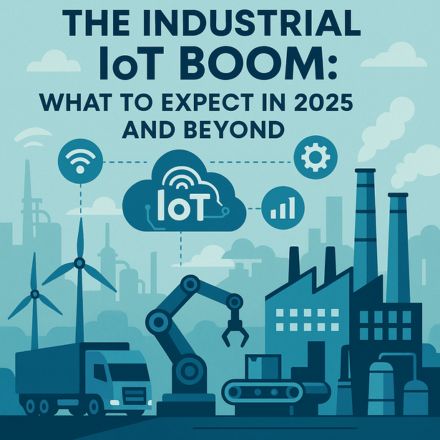The industrial landscape is undergoing a seismic shift. As we move deeper into a connected era, the industrial Internet of Things (IoT) is becoming the backbone of smarter factories, efficient logistics, predictive maintenance, and seamless supply chains. With global industrial IoT spending expected to surpass $1 trillion by 2025, it’s clear that the enterprise IoT expansion wave is no longer approaching—it’s already here.
From heavy manufacturing to energy, transportation, and agriculture, businesses are leveraging connected devices to gain real-time insights, automate processes, and make smarter decisions. As we step into 2025 and beyond, here’s what to expect from the industrial IoT revolution—and how organizations can prepare to ride the wave.
What Is Industrial IoT?
Industrial IoT refers to the use of smart sensors, devices, and software to enhance industrial processes. These connected systems collect, analyze, and act on data in real time—transforming everything from production lines to remote monitoring in oil rigs or warehouses.
It brings together operational technology (OT) and information technology (IT) to create robust, intelligent infrastructure.
Key Drivers Behind Enterprise IoT Expansion
Several trends are fueling the acceleration of enterprise IoT expansion in 2025:
1. Advanced Connectivity with 5G and Edge Computing
Faster, more reliable networks are enabling seamless communication between devices. 5G technology combined with edge computing reduces latency and allows data processing closer to the source, making industrial IoT applications more responsive and efficient.
2. Increased Automation and AI Integration
Artificial intelligence and machine learning are transforming IoT data into actionable insights. Smart algorithms can now predict equipment failures, optimize energy consumption, and detect anomalies—driving operational efficiency and reducing downtime.
3. Digital Twin Adoption
Digital twins—virtual replicas of physical assets—are gaining momentum. In industrial settings, they help monitor equipment performance in real time and simulate scenarios for better decision-making.
4. Sustainability and Green Manufacturing
As sustainability becomes a core business value, companies are turning to industrial IoT for real-time emissions tracking, waste reduction, and energy optimization—supporting both compliance and corporate responsibility.
5. Post-Pandemic Supply Chain Resilience
COVID-19 exposed weaknesses in global supply chains. In response, businesses are using IoT to improve visibility, automate inventory tracking, and make logistics more adaptive and resilient.
Sectors Leading the Industrial IoT Boom
Certain industries are at the forefront of enterprise IoT expansion:
- Manufacturing: Smart factories are using IoT to enable predictive maintenance, reduce defects, and enhance quality control.
- Energy and Utilities: Smart grids and connected meters offer greater efficiency, real-time monitoring, and demand forecasting.
- Logistics and Transportation: IoT-enabled fleet tracking, route optimization, and cargo condition monitoring are streamlining global shipping.
- Healthcare: Industrial-grade IoT devices support medical equipment tracking, sterilization automation, and facility operations.
Top Benefits of Industrial IoT in 2025
1. Predictive Maintenance
Instead of reacting to failures, companies can use IoT sensors to predict and prevent breakdowns—saving time, money, and resources.
2. Operational Efficiency
Real-time analytics optimize workflows, reduce energy consumption, and help streamline resource allocation.
3. Worker Safety
IoT devices can monitor environmental conditions, track worker movements, and alert personnel to potential hazards—enhancing safety in high-risk environments.
4. Asset Tracking
From tools and machines to vehicles and raw materials, IoT ensures assets are where they should be—and functioning as expected.
Challenges to Overcome
Despite the promise of industrial IoT, organizations must address several challenges to ensure successful adoption:
- Security and Privacy: With more connected endpoints, the risk of cyberattacks increases. Strong encryption, device authentication, and continuous monitoring are critical.
- Interoperability: Integrating devices from different vendors requires standardization and open protocols.
- Legacy Systems: Many enterprises still operate on outdated infrastructure. Transitioning to smart systems requires significant investment and planning.
- Data Management: The volume of data generated by IoT systems can be overwhelming without proper tools for storage, analysis, and decision-making.
Preparing for the Future of Enterprise IoT Expansion
To thrive in the IoT-driven industrial era, businesses should:
- Start with a Strategic Plan: Define clear objectives, identify key metrics, and align IoT initiatives with business goals.
- Invest in Scalable Infrastructure: Cloud platforms, edge computing, and AI-driven analytics are key enablers of future-ready IoT.
- Prioritize Security: Implement end-to-end security policies, including secure device onboarding, real-time threat detection, and regular updates.
- Foster Collaboration: Encourage cross-functional collaboration between IT, operations, and leadership to maximize IoT value.
Conclusion: The Connected Industrial Future
The industrial IoT boom isn’t just about adopting new technologies—it’s about reimagining how businesses operate, innovate, and compete. In 2025 and beyond, the most successful enterprises will be those that embrace connected intelligence, build secure and agile systems, and adapt swiftly to change.
The wave of enterprise IoT expansion is creating massive opportunities for efficiency, sustainability, and growth. By staying ahead of the curve and investing in the right technologies, businesses can transform their operations and lead in a rapidly evolving digital world.
